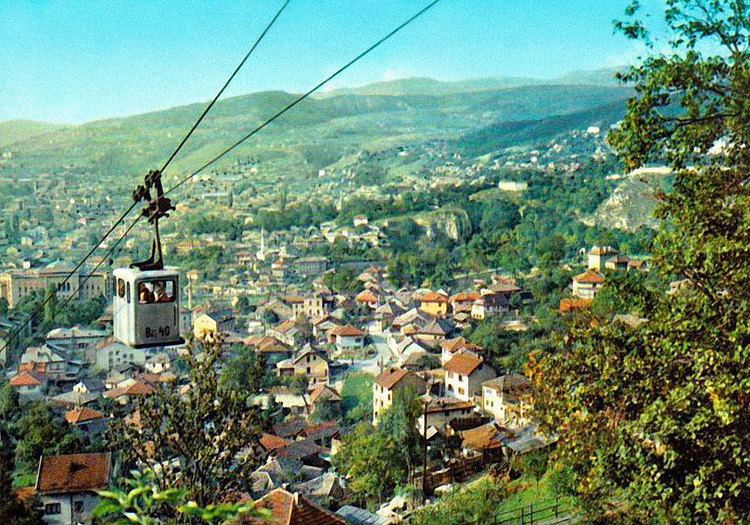Elevation 1,627 m | ||
 | ||
Similar | ||
Trebević (Serbian Cyrillic: Требевић) is a mountain in central Bosnia and Herzegovina. It is found directly to the southeast of Sarajevo, territory of East Sarajevo city, bordering Jahorina mountain. Trebević is 1627 meters (5338 ft) tall, making it the second shortest of the Sarajevo mountains.
Contents
- Map of TrebeviC487 Bosnia and Herzegovina
- Mineral and Crystal deposits
- Orthodox cross controversy
- References
Map of Trebevi%C4%87, Bosnia and Herzegovina
During the Middle Ages, Trebević was known as Zlatni Do. During the 1984 Winter Olympics Trebević, like the other Sarajevo mountains, was used for a number of Olympic events, such as bobsledding. During the Siege of Sarajevo, Trebević took on a darker role as its elevations proved ideal positions for besieging artillery and the mountain became a key fighting ground.
Trebević today is not as important of a tourist destination as Igman or Bjelašnica, largely due to the heavy fighting that took place in the early 1990s. Still, most of the land mines are now cleared. There are numerous hotels, mountaineering homes, and other such structures on Trebević and the immediate area.
Trebević has been the main excursion site of Sarajevo citizens due to the favorable geographical position, climate and the beauty of the nature. The biological diversity is among the highest and it is extraordinary to find such a phenomenon near the hearth of the big city. On 9 April 2014, Sarajevo Canton Assembly, announced Trebević as a protected area, in order to conserve and improve each element of the geographical and biological diversity.
Mineral and Crystal deposits
The area is known to contain quartz, siderite, and calcite crystal deposits and one such item is on display in Sarajevo at the National Museum of Bosnia and Herzegovina.
Orthodox cross controversy
In March 2008, a Bosnian Serb organization Savez logoraša Republike Srpske (Association of Bosnian Serb War Prisoners), led by Branislav Dukić, announced its intention to erect a giant 26-meter (85 foot) high Orthodox Christian cross at the part of the mountain on Republika Srpska territory in order to commemorate the Serb victims in Sarajevo during the Bosnian War. The idea followed a move by Bosnian Croats who erected a Catholic Christian cross on Hum Hill above Mostar, remembering Croats killed there during the Bosnian War. High Representative for Bosnia and Herzegovina Miroslav Lajčák also asked Republika Srpska authorities not to allow the construction of the cross.
The Sarajevo Association of War Victims criticized the plan to build the cross, calling it shameful to build the memorial in a location from which the Serb artillery pounded the city, killing thousands of people. The association issued a statement calling the planned monument a "provocation for the citizens of Sarajevo."
Residents of Sarajevo, witnesses in the U.N. International Criminal Tribunal for the Former Yugoslavia (ICTY) prosecutions, confirmed that during the war, city was shelled frequently from firing positions at Mount Trebević, harming many civilians. The ICTY has convicted two Bosnian Serb generals of war crimes for ordering the relentless shelling, sniping and indiscriminate terror in Sarajevo during the 44-month siege. The artillery position on Trebević was one of the deadliest. In the ICTY prosecution of Dragomir Milošević and Stanislav Galić, a former commanders of the Sarajevo-Romanija Corps of the Republika Srpska Army, he was sentenced to 29 years in prison for the terror, murder and inhumane acts conducted during a campaign of sniping and shelling which resulted in the injury and death of a great number of civilians in the besieged Bosnian capital. A huge part of the shelling and sniping came from the slopes of Mount Trebević. ICTY trial chamber also found that "the mortar shell causing second Markale massacres at around 11:00 AM on 28 August 1995. was fired from the (Bosnian-Serb) VRS held territory on the slopes of Mt. Trebević.
Citizens, NGO and city representatives of Sarajevo on 3 January every year commemorate the tragic death of six members of Tatarević - Dragnić family (among them two kids, Asja 10 and Nadan 16 years old) who were killed in their apartment during the lunch by the shell that came from the Republica Srpska Army position at the Trebević.
As of October 2013, the construction is reportedly still in the preparation phase.
